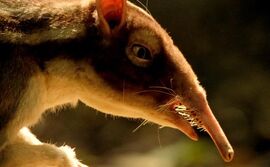Amongst the animals perfectly fossilised in the Messel shales of Germany are three species of Leptictidium. The fossils show us a complete outline of the body and the fur because bacteria that were on the fur when the animal sank to the bottom of the lake have themselves been fossilised, and are darker than the surrounding rock. Some of the fossils also have stomach contents fossilised inside them, so we know these animals ate a mixture of insects, smaller mammals and lizards. Traits & Evidence[]Three species of Leptictidium are found perfectly preserved in the Messel shales in Germany, but the leptictid family was widespread - found across Europe and North America since before the dinosaurs became extinct. Leptictidium has small front legs and large backlegs, so it obviously moved on two legs much of the time. The question is, did it run or hop? Initially palaeontologists had thought that Leptictidium ran on its hind legs as the ankle and hip joints looked to be too weak to withstand the rigours of bouncing. However, a reanalysis of the skeleton by another group of palaeontologists disagreed. They argued that the long, narrow feet would not have been stable for running, but were much more like those of hopping animals. Going back to more fundamental principles: today, we are the only mammals that run on two legs, and we have a fully upright body posture. All other bipedal mammals hop, with their body held more or less horizontally. This is probably because hopping flexes the spine up and down in the same way that galloping does in mammals, whilst running on two legs in the same posture would pose different stresses on the body. Hopping then is an easier step from four-legged galloping. There is still much debate about this, though, so maybe some day someone will show that we got it wrong. Reconstructing the behaviour of extinct animals is always a matter of educated guesswork. In some cases we have evidence for particular aspects of an animal's behaviour. At other times we have to look to modern animals for comparison. Leptictidium was a fast-moving, medium-sized insectivorous mammal living on the forest floor and so we can piece together several likely scenarios. First, because its young would have been extremely vulnerable to predators on the ground it is likely that they were born well-developed and were quick to become independent. Other behaviour is based on modern animals that live in a similar way. For example, shrews take their young with them when they go hunting when the babies are nearly fully grown. The youngsters learn what to hunt by licking their mother's mouth when she catches things, learning the taste of good prey. The young Leptictidium may well have had to learn using the same techniques, so they too could have followed their mother out when she hunted before they left the nest completely. Appearance[]The preservation in the Messel shales of Germany is so good that even the fur outline is visible, because of dark fossilised bacteria that covered the hair. This allows us to reconstruct the fur of animals like Leptictidium with confidence and shows us that Leptictidium had a bald tail. The skull of Leptictidium shows that it had areas for the attachment of relatively large muscles on the snout, suggesting that it had a long, mobile nose, like other animals that hunt on the forest floor such as elephant shrews. Three species of Leptictidium are found in the Messel shales of Germany. The smallest ( Leptictidium auderiense) is about 60cm long, the middle-sized one ( Leptictidium nasutum) is about 75cm long and the largest, which is featured in the series (Leptictidium tobieni) is 90cm from nose to tail. This is about the size of a large cat. In Walking with Beasts[]New Dawn[] |
|||||||||||||||
Advertisement
23
pages
Leptictidium
Advertisement
